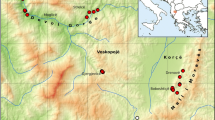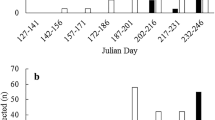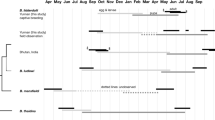Abstract
Teinopalpus aureus (Lepidoptera: Papilionidae) is endemic to the mountains of southern China and Vietnam. This butterfly species was the focus of several high profile poaching cases in China and influenced conservation policies in the country because of this attention. In this study we closely monitored 2.25 km2 of the butterfly’s known habitat in Mt. Dayao Nature Reserve, Guangxi Province, China, from 2012 to 2014. A total of 33 magnolia host plants were found in the plot, and 28 individuals were reared from the egg/early larval stage until they pupated or died. We found T. aureus sufficiently difficult to breed and failed to induce oviposition in captivity. In 2015, a public museum was built in Mt. Dayao Nature Reserve to raise conservation awareness of local biodiversity, which specifically featured an exhibition of T. aureus. To investigate whether the museum was effective in increasing local conservation awareness, in 2013, 2015 and 2017, a total of 1022 local residents were interviewed regarding their conservation awareness of the butterfly. Conservation awareness significantly increased with time from 2013 to 2017, but this was also strongly influenced by residence location and respondent age.



Similar content being viewed by others
References
Almada-Villela PC (1988) Checklist of fish and invertebrates listed in the CITES appendices. Nature Conservancy Council, London
Ballard HL, Dixon CGH, Harris EM (2017a) Youth-focused citizen science: examining the role of environmental science learning and agency for conservation. Biol Conserv 208:65–75
Ballard HL, Robinson LD, Young AN, Pauly GB, Higgins LM, Johnson RF, Tweddle JC (2017b) Contributions to conservation outcomes by natural history museum-led citizen science: examining evidence and next steps. Biol Conserv 208:87–97
Bell P, Lewenstein B, Shouse A, Feder MA (2009) Learning sciences in informal environments: people, places and pursuits. National Academies Press, Washington, DC
Black SH, Vaughan DM (2005) Species profile: Boloria acronema. In: Shepherd MD, Vaughan DM, Black SH (eds) Red list of pollinator insects of North America, CD-ROM Version 1, The Xerces Society for Invertebrate Conservation, Portland
Bonebrake TC, Ponisio LC, Boggs CL, Ehrlich PR (2010) More than just indicators: a review of tropical butterfly ecology and conservation. Biol Conserv 143:1831–1841
Bordeleau X, Hatcher BG, Denny S, Fast MD, Whoriseky FG, Patterson DA, Crossin GT (2018) Consequences of captive breeding: fitness implications for wild-origin, hatchery-spawned Atlantic salmon kelts upon their return to the wild. Biol Cons 225:144–153
Breiman L (2001) Random forests. Mach Learn 45:5
Brückmann SV, Krauss J, Steffan-Dewenter I (2010) Butterfly and plant species suffer from reduced connectivity in fragmented landscapes. J Appl Ecol 47:799–809
Chen Y (2018) Changsha Haiguan Cong Yinni Jinjing Youjian Zhong Jiehuo 415 Zhi Kunchong Biaoben [415 Insect Specimen Found from Package entering Custom]. http://hn.rednet.cn/c/2018/09/05/4722804.htm Accessed 8 Sept 2018
Chen RL, Gu MB (2009) Questions and prospects in the study of Teinopalpus aureus. Environ Entomol 31:80–84
Chen L, Cai Y, Gong Y, Gu M (2009) Two new hosts of Teinopalpus aureus mell found in the Nanling National Nature Reserve. Guangdong For Sci Technol 25(6):119–120
Cheng Y (2002) Guangxi 10 Qiangdao Liesha 250 Zhi Jinbanhuifengdie [Guangxi: 10 robbers killed 250 Teinopalpus aureus]. http://www.china.com.cn/chinese/ huanjing/173513.htm. Accessed 8 Sept 2018
Collins NM, Morris MG (1985) Threatened swallowtail butterflies of the world: the IUCN red data book. IUCN, Gland
Cooney R, Roe D, Dublin H, Phelps J, Wilkie D, Keane A, Travers H (2017) From poachers to protectors: engaging local communities in solutions to illegal wildlife trade. Conserv Lett 10(3):367–374
Davidson S, Passmore C, Anderson D (2010) Learning on zoo field trips: the interaction of the agendas and practices of students, teachers, and zoo educators. Sci Educ 94(1):122–141
Derrickson SR, Snyder NFR (1992) Potentials and limits of captive breeding in parrot conservation. In: Beissinger SR, Snyder NFR (eds) New World parrots in crisis: solutions from conservation biology. Smithsonian Institution Press, Washington, DC, pp 133–163
Dickinson JL, Shirk J, Bonter D, Bonney R, Crain RL, Martin J, Phillips T, Purcell K (2012) The current state of citizen science as a tool for ecological research and public engagement. Front Ecol Environ 10(6):291–297
Environmental Systems Research Institute (ESRI) (2012) ArcGIS release 10.1. Environmental Systems Research Institute (ESRI), Redlands
Forsyth CJ, Marckese TA (1993) Thrills and skills: a sociological analysis of poaching. Deviant Behav 14:157–172
Fraser J, Sickler J (2009) Measuring the cultural impact of zoos and aquariums. Int Zoo Yearb 43(1):103–112
Ghoddousi A, Soofi M, Hamidi AK, Lumetsberger T, Egli L, Ashayeri S, Khorozyan I, Kiabi B, Waltert M (2017) When pork is not on the menu: assessing trophic competition between large carnivores and poachers. Biol Conserv 209:223–229
Hayfield T, Racine JS (2008) Nonparametric econometrics: the np package. J Stat Softw 27(5)
Huang S, Tian M, Wang M, Chen J, Bi X, Cai Y, You Z (2002) Study on the population status of Teinopalpus aureus mell in China. Wuyi Sci J 18:269–271
Igarashi S (2001) Life cycle of Teinopalpus aureus in Vietnam in comparison with that of T. imperials butterflies. Lepidoptera 30:4–24
Igarishi S, Fukada H (2000) The life histories of Asian butterflies, vol 2, Tokai University Press, Tokai, pp 358–363
Jacoby K (2001) Crimes against nature: squatters, poachers, thieves, and the hidden history of American conservation. University of California Press, Berkeley
Jarvis A, Reuter HI, Nelson A, Guevara E (2008) Hole-filled SRTM for the globe Version 4, available from the CGIAR-CSI SRTM 90m database. http://srtm.csi.cgiar.org
Jones CG, Heck W, Lewis RE, Mungroo Y, Slade G, Cade T (1995) The restoration of the Mauritius Kestrel Falco punctatus population. Ibis 137(Supplement 1):173–180
Kainer KA, Digiano ML, Duchelle AE, Wadt LHO, Bruna E, Dain JL (2009) Partnering for greater success: local stakeholders and research in tropical biology and conservation. Biotropica 41(5):555–562
Kampstra P (2008) Beanplot: a boxplot alternative for visual comparison of distributions. J Stat Softw Code Snippets 28(1):1–9
Kang C, Anderson D, Wu X (2009) Chinese perceptions of the interface between school and museum education. Cult Stud Sci Educ 5(3):665–684
Kapos V, Balmford A, Aveling R, Bubb P, Carey P, Entwistle A, Hopkins J, Mulliken T, Safford R, Stattersfield A, Walpole M, Manica A (2008) Calibrating conservation: new tools for measuring success. Conserv Lett 1(4):155–164
Karube H (2010) Endemic insects in the Ogasawara Islands: negative impacts of alien species and a potential mitigation strategy. In: Kawakami K, Okochi I (eds) Restoring the oceanic island ecosystem. Springer, Tokyo, pp 133–137
Kellert SR (1996) The value of life. Island Press, Washington, DC
King H, Achiam M (2017) The case for natural history. Sci Educ 26:125–139
Lampinen J, Heikkinen RK, Manninen P, Ryttari T, Kuussaari M (2018) Importance of local habitat conditions and past and present habitat connectivity for the species richness of grassland plants and butterflies in power line clearings. Biodivers Conserv 27(1):217–233
Li T (2017) Quanguo Zuida Binwei Hudie Zousian Xuanpan [Biggest endangered butterfly smuggling case in the nation, 3 people got 5 year sentence]. http://www.chinanews.com/sh/2017/11-07/8370026.shtml. Accessed 8 Sept 2018
Li X, Settele J, Schweiger O, Zhang Y, Lu Z, Wang M, Zeng J (2013) Evidence-based environmental laws for China. Science 341:958
Lindeman RH, Merenda PF, Gold RZ (1980) Introduction to bivariate and multivariate analysis. Scott Foresman & Co, Glenview
McKinney ML (2002) Urbanization, biodiversity, and conservation. Bioscience 52(10):883
Mell R (1923) Noch unbeschriebene Lepidopteren aus Südchina, II. Deut Entomol Z Iris 1923:153
Micklethwait J (2013) Mad about museums. Economist 409:8
Priddle D, Carlile N, Humphrey M, Fellenberg S, Hiscox D (2003) Rediscovery of the ‘extinct’ Lord Howe Island stick-insect (Dryococelus australis (Montrouzier)) (Phasmatodea) and recommendations for its conservation. Biodivers Conserv 12(7):1391–1403
R Development Core Team (2015) R: a language and environment for statistical computing. R Foundation for Statistical Computing, Vienna
Salafsky N, Margoluis R (1999) Threat reduction assessment: a practical and cost-effective approach to evaluating conservation and development projects. Conserv Biol 13(4):830–841
Sands D (2008) Conserving the Richmond birdwing butterfly over two decades: where to next? Ecol Manag Restor 9(1):4–16
Simberloff D (1998) Flagships, umbrellas, and keystones: is single-species management passé in the landscape era? Biol Conserv 83(3):247–257
Snyder NFR, Snyder HA (1989) Biology and conservation of the California condor. Curr Ornithol 6:175–263
Snyder N, Derrickson S, Beissinger S, Wiley J, Smith T, Toone W, Miller B (1996) Limitations of captive breeding in endangered species recovery. Conserv Biol 10(2):338–348
Song Y, Zeng B, Chen C, Zuo C, Cheng Y, Guo W, Zeng X (2007) Teinopalus aureus found in Jinggangshan of Jiangxi. Jiangxi Sci 4:030
Tal R, Bamberger Y, Morag O (2005) Guided school visits to natural history museums in Israel: teachers’ roles. Sci Educ 89(6):920–935
Vance-Borland K, Holley J (2011) Conservation stakeholder network mapping, analysis, and weaving. Conserv Lett 4(4):278–288
Walpole MJ, Leader-Williams N (2002) Tourism and flagship species in conservation. Biodivers Conserv 11(3):543–547
Wang Y, Lin L, Zhen F, Wu H (2009) Teinopalpus aureus firstly found in Zhejiang. J Zhejiang For Coll 26(1):147–148
Wengraf T (2001) Qualitative research interviewing: biographic narrative and semi-structured methods. SAGE, Thousand Oaks
Wu X (2007) Xiongying Zhanchi Dayaoshan [Eagle Spread Wings at Mt. Dayao]. For Guangxi 5:54–55
Yim S (2005) Globalization and the development of museums in China. Curator 48(1):27–29
Zeng J, Zhou S, Luo B, Qin K, Wu J (2007) Life history of Teinopalpus aureus guangxiensis Chou et Zhou (Lepidoptera :Papilionidae). Guangxi Sci 14(3):323–326
Zhang J (2016) Beijing Haiguan Shouci Kuaijian Qudao Jiehuo Kunchong Biaoben [Beijing Custom intercept Insect Specimen]. http://www.legaldaily.com.cn/index_article/content/2016-03/25/content_6539795.htm?node=5955. Accessed 8 Sept 2018
Acknowledgements
We are deeply indebted to the staff at Mt. Dayao Natural Reserve for their logistic support: B. Luo; H. Tao, J. Chen, J. Tao and W. Zhao. We thank Z. Deng for helping with the interviews. We thank J. Weintraub from the Academy of Natural Sciences for his advice on breeding butterfly in captivity. We thank N. Pierce and K. Gilbert from the Harvard Museum of Comparative Zoology for help with revising our manuscript. Funding for this research is provided by the Lande Research Fund from Department of Biology, Swarthmore College and a Natural Science Fund from the Department of Forestry of Guangxi Province (No.127. [2011]). We are grateful to two anonymous reviewers for their valuable comments on the manuscript.
Author information
Authors and Affiliations
Corresponding author
Ethics declarations
Conflict of interest
The authors declare that they have no conflict of interest.
Informed consent
Informed consent was obtained from all individuals included in the study.
Research involving human and animal participants
License for obtaining and rearing Teinopalpus aureus was issued by the People’s Republic of China Forestry Bureau.
Electronic supplementary material
Below is the link to the electronic supplementary material.
Rights and permissions
About this article
Cite this article
Wang, Z., Huang, Y., Luo, X. et al. Habitat monitoring of an endangered Asian butterfly, Teinopalpus aureus (Lepidoptera: Papilionidae) and change in local residents’ conservation awareness. J Insect Conserv 22, 721–729 (2018). https://doi.org/10.1007/s10841-018-0096-2
Received:
Accepted:
Published:
Issue Date:
DOI: https://doi.org/10.1007/s10841-018-0096-2




